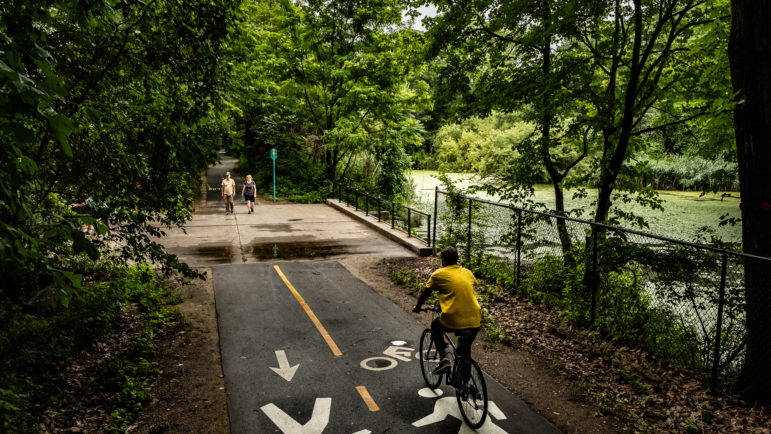The mayor’s office has approved the highest funding for tree planting in half a decade, officials say, allowing the Parks Department to plant 20,000 trees a year for the next four years. But some councilmembers say that pace isn’t fast enough to keep up with extreme weather events that damage the city’s tree canopy.

Adi Talwar
Tree-covered Old Putnam Trail located in Van Cortlandt Park in the Bronx.In an oversight hearing Thursday afternoon, Councilmembers drilled the Department of Parks and Recreation on its progress in equitably increasing tree canopy across the city—noting that the threat of more frequent and extreme weather events makes the need for stewarding trees more urgent than ever.
“This is both a climate justice issue as well as a racial justice issue,” Shekar Krishnan, chair of the Committee on Parks and Recreation, told City Limits. “Not only do we need much more tree canopy coverage in the city, but this actually affects communities of color disproportionately in the sense that less tree canopy coverage there directly translates into hotter temperatures on average for some neighborhoods in the city than others.”
During the three-hour hearing, councilmembers quizzed Jennifer Greenfeld, the Parks Department’s deputy commissioner for environment and planning, on issues related to cost and administrative red tape involved in planting trees across the city.
She noted that the mayor’s office has approved the highest funding for tree planting in half a decade, allowing the department to plant 20,000 trees a year for the next four years.
Earlier this month, Mayor Eric Adams committed to boost the budget for the Parks Department to $624.2 million, marking the largest parks budget in the city’s history, according to New Yorkers for Parks. The budget added new positions and funding for community gardens and parks equity initiatives, but still fell short of the $1 billion Adams pledged to commit when campaigning for office, as advocates have pushed for the city to allocate 1 percent of its total budget to parks.
The Parks department controls about 22,000 acres of the city’s 42,656 acres of tree canopy, according to Greenfeld. “The rest of New York City’s canopy — that’s 47 percent — grows on a combination of private and public land parcels, such as residential front- and backyards, NYCHA campuses, cemeteries, vacant land and on public lands not managed by NYC parks.”
During the hearing, Queens Councilmember Bob Holden noted the need to prune trees and prevent damage from extreme weather events.
“Planting 20,000 trees is a drop in the bucket, I think, in a particular year, considering all the storms we’ve had in the city of New York,” he said in the meeting.
The committee report noted that two tornadoes in 2010 killed more than 40 trees and damaged more than 1,600, and Superstorm Sandy knocked over more than 8,500 trees and caused over $725 million in damages to parks.
“Though the recent Tropical Storm Ida did not result in a great deal of tree damage, the concern is that more frequent and severe storms in the near future will result in even more damage to the tree stock, as global warming is expected to cause sea level rise and storms to intensify in the City,” the report said.
Although the overall citywide canopy has grown between 2010 and 2017, according to a report by the Nature Conservancy last fall, some neighborhoods experienced local losses in canopy related to extreme weather. “We really need to be working more on our heat mitigation strategies, and our urban forest plays a critical role,” said Emily Nobel Maxwell of the Nature Conservancy during public testimony at the hearing.
Councilmembers also questioned Greenfeld on the cost of planting trees — $3,600 a tree, citywide, Greenfeld testified. Minority leader Joe Borelli cited a 2018 report showing that Jersey City pays only $500 for new trees.
“Can we think of any other example where New York City pays seven times the amount that an adjacent municipality pays for a service?” he asked. “Can we contract Jersey City to plant our trees?”
He went on to say that he wanted to see lower cost, better contractors or in-house work, volunteer programs or even a simpler way for homeowners to plant trees without receiving violations. “I think all of these things collectively add up to our problem. And the cost is a major part of that problem,” he said.
Brooklyn Councilmember Lincoln Restler criticized the difficulty to get approvals on tree plantings in his district, despite community involvement, and the slow process of planting even after approval. “We need more trees,” he said. “This is the most single consequential solution to the climate crisis.”
City Limits previously reported on a recent study by Columbia Climate School that used community-collected data to map urban heat islands—areas in the city prone to higher-than-average temperatures. The results, released in January, confirmed that Inwood, Washington Heights and the South Bronx were on average hotter than other parts of Manhattan measured by researchers.
READ MORE: NYC Heat Mapping Study Finds Higher Temps in Lower-Income Neighborhoods
These neighborhoods match areas with less access to air conditioning and other resources, according to the researchers.
Last summer, a report by American Forests found that New York City would need to add 1.5 million trees to provide equitable tree canopy across the city. The report noted that nationally, majority-white and wealthier neighborhoods had more distribution of greenery than low-income neighborhoods and communities of color.
“This is the consequence of historic prolonged practices and other things that were discriminatory and racist across the country,” Chris David of American Forests told City Limits following the release of the report.
The Council hearing comes just a week after the city’s Health Department released a report showing that the city averages 370 heat-related deaths a year. Using data from 2011 to 2020, the report also found that the death rate was twice as high for Black New Yorkers than white New Yorkers. (Last year’s report found similar disparities.)
Organizers with the New York City Environmental Justice Alliance have argued that number might be even higher, as the city counts heat-related deaths as those that occur within just three days of a heat wave.
“Increased transparency of data and rigorousness of analysis has enabled us to see a much clearer and more comprehensive view of how heat impacts mortality in NYC,” the organization’s president Eddie Bautista noted in a recent newsletter.
Liz Donovan is a Report for America corps member.










2 thoughts on “‘We Need More Trees’: City Council Probes Planting Progress”
Dear Ms. Donovan,
I really enjoyed this article. It confirms my suspicions that the city is paying a ridiculous price to have trees planted. I have been waiting 3 years to have a stump removed and a tree planted. I was just recently notified it will be another year. In order to do it in my own I have to get a landscaper and a permit. cost is about $1500. Why can’t I do it on my own? Cost about $ 150. If I remove and plant I will get fined. I’ve been writing and calling Queens parks pleading for a tree because it is so hot in front of my house. No answer. What am I paying property and income tax for??? I am so frustrated by this process. If you can help me get a tree that would be greatly appreciated!
Ms. Donovan.
‘We Need More Trees’: City Council Probes Planting Progress”. Bah Humbug. The impetus to expand vitally needed urban tree canopy (UTC) as much as 30% by 2030 as determined by NYC Parks officials like Greenfeld and others- is not found in even more costly plant-it and walk-away street tree installations- but preserving what large trees and their canopy already exist and that deliver innumerable benefits and services that we seek from them. But the 30% goal clearly is untenable bc it is Parks Forestry and Greenfeld by their long tradition of the gross mismanagement of our vital public tree assets that is the core driver behind significant needless annual losses of these trees that most assume to be protected. By giving a pass to scores of builders and developers in the 5-boros Greenfeld and this revenue generating agency have turned many of these living and irreplaceable, carbon sequestering, climate change abatters into the agency cash cow- all for sale. To get an idea just how many trees and the canopy we loose annually in NYC, just weed out the NYC data in 2 Nowak and Greenfield papers below.
This is followed by two other historic major denuders of our urban forest, NYCHA and NYS DOT. For the latter, you need to visit Queens where 3 NYS capital road widening projects have eviscerated hundreds of large veteran shade forest trees, even in neighborhoods with POC.
2012.
https://www.semanticscholar.org/paper/Tree-and-impervious-cover-change-in-U.S.-cities-Nowak-Greenfield/4ca3aef51cefdcfe1162c8a3b14528507060837e
2018
https://www.fs.usda.gov/nrs/pubs/jrnl/2018/nrs_2018_nowak_005.pdf
2020
https://www.fs.usda.gov/nrs/pubs/jrnl/2020/nrs_2020_nowak_002.pdf